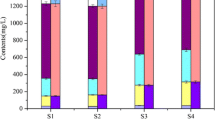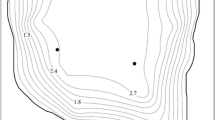Abstract
Because different phosphorus (P) forms vary greatly in their bioavailability, total phosphorus concentrations are a problematic predictor of the eutrophication potential of natural surface waters and wastewater treatment facility effluents. It is currently not known which operational P characterizations (i.e., dissolved/particulate and reactive/non-reactive) best predict effluent P bioavailability. We characterized the P speciation and directly measured the bioavailability of P (BAP) using algal bioassays for 14 full-scale advanced nutrient removal wastewater treatment plants representing a wide range of P removal technologies. A strong statistical relationship was observed between the effluent total BAP (tBAP) and total reactive P (TRP) (r 2 ≈ 0.81), with a tBAP/TRP ratio of 0.61 ± 0.24, indicating that TRP can be used as a conservative surrogate predictor of tBAP. A comparison of different operational categories for phosphorus indicated that sBAP is consistently lower than both soluble P (SP) and soluble reactive P (SRP) with average ratios of 0.34 ± 0.19 and 0.62 ± 0.27, respectively. This shows a large fraction of the dissolved non-reactive P (i.e., SP−SRP), and ≥40 % of the P classified as SRP was not bioavailable. Total BAP concentrations were on average 30 % higher than soluble BAP (sBAP) concentrations, indicating that the particulate P fraction was an important component of the BAP for the tested effluents. Comparisons between different P removal technologies suggest the bioavailability, and P species composition varies with the nutrient removal process, and that in many cases, a large portion (>60 %) of the effluent P is recalcitrant to algal growth.






Similar content being viewed by others
References
American Public Health A, American Water Works A, Water Environment F (2005) Standard methods for the examination of water and wastewater. American Public Health Association, Washington, DC
Anderson BH, Magdoff FR (2005) Autoclaving soil samples affects algal-available phosphorus. J Environ Qual 34(6):1958–1963. doi:10.2134/jeq2005.0024
Benisch M, Clark D, Neethling JB, Gu AZ (2007) Can tertiary phosphorus removal reliably produce 10 µg/l,pilot results from coeur d’alene, id. In: Baltimore IWA/WEF nutrient conference
Berman T (1988) Differential uptake of ortho-phosphate and organic phosphorus substrates by bacteria and algae in lake kinneret. J Plankton Res 10(6):1239–1249
Bjorkman K, Karl DM (1994) Bioavailability of inorganic and organic phosphorus compounds to natural assemblages of microorganisms in hawaiian coastal waters. Mar Ecol Prog Ser 111(3):265–273
Bjorkman KM, Karl DM (2003) Bioavailability of dissolved organic phosphorus in the euphotic zone at station aloha, north pacific subtropical gyre. Limnol Oceanogr 48(3):1049–1057
Bostrom B, Persson G, Broberg B (1988) Bioavailability of different phosphorus forms in fresh-water systems. Hydrobiologia 170:133–155
Bradford ME, Peters RH (1987) The relationship between chemically analyzed phosphorus and bioavailable phosphorus. Limnol Oceanogr 32(5):1124–1137
Chamberlain W, Shapiro J (1969) On the biological significance of phosphate analysis; comparison of standard and new methods with a bioassay. Limnol Oceanogr 14(6):921–927
Ekholm P, Krogerus K (2003) Determining algal-available phosphorus of differing origin: routine phosphorus analyses versus algal assays. Hydrobiologia 492(1–3):29–42. doi:10.1023/a:1024857626784
Ekholm P, Jouttijarvi T, Priha M, Rita H, Nurmesniemi H (2007) Determining algal-available phosphorus in pulp and paper mill effluents: algal assays vs routine phosphorus analyses. Environ Pollut 145(3):715–722. doi:10.1016/j.envpol.2006.06.001
Ellis BK, Stanford JA (1988) Phosphorus bioavailability of fluvial sediments determined by algal assays. Hydrobiologia 160(1):9–18
Ellison ME, Brett MT (2006) Particulate phosphorus bioavailability as a function of stream flow and land cover. Water Res 40(6):1258–1268. doi:10.1016/j.watres.2006.01.016
Elser JJ, Bracken MES, Cleland EE, Gruner DS, Harpole WS, Hillebrand H, Ngai JT, Seabloom EW, Shurin JB, Smith JE (2007) Global analysis of nitrogen and phosphorus limitation of primary producers in freshwater, marine and terrestrial ecosystems. Ecol Lett 10(12):1135–1142. doi:10.1111/j.1461-0248.2007.01113.x
Gu AZ, Neethling JB, Benisch M, Clark D, Fisher D, Fredrickson HS (2007) Advanced phosphorus removal from membrane filtrate and filter filtrate using packed columns with different adsorptive media. In: 80th Annual Water Environmental Federation Annual Conference and Exposition, Wastewater Treatment Research, San Diego
Hudson JJ, Taylor WD, Schindler DW (2000) Phosphate concentrations in lakes. Nature 406(6791):54–56
Jansson M (1977) Enzymatic release of phosphate in water from subarctic lakes in northern sweden. Hydrobiologia 56(2):175–180. doi:10.1007/bf00023356
Kerouel R, Aminot A (1996) Model compounds for the determination of organic and total phosphorus dissolved in natural waters. Anal Chim Acta 318(3):385–390
Lancaster CD, Madden JE (2008) The impact of recalcitrant phosphorus on the ability to meet low phosphorus limits. In: 81st Annual Water Environmental Federation Annual Conference and Exposition, Wastewater Treatment Research, Chicago
Lewis WM, Wurtsbaugh WA (2008) Control of lacustrine phytoplankton by nutrients: erosion of the phosphorus paradigm. Int Rev Hydrobiol 93(4–5):446–465. doi:10.1002/iroh.200811065
Li B, Brett MT (2012) The impact of alum based advanced nutrient removal processes on phosphorus bioavailability. Water Res 46(3):837–844. doi:10.1016/j.watres.2011.11.055
Li B, Brett MT (2013) The influence of dissolved phosphorus molecular form on recalcitrance and bioavailability. Environ Pollut 182:37–44
Miller WE, Greene JC, Shiroyama T, Corvallis Environmental Research Laboratory (1978) The selenastrum capricornutum printz algal assay bottle test: experimental design, application, and data interpretation protocol. Environmental Protection Agency, Office of Research and Development, Corvallis Environmental Research Laboratory, Corvallis
Monaghan EJ, Ruttenberg KC (1999) Dissolved organic phosphorus in the coastal ocean: reassessment of available methods and seasonal phosphorus profiles from the eel river shelf. Limnol Oceanogr 44(7):1702–1714
Nausch M, Nausch G (2004) Bacterial utilization of phosphorus pools after nitrogen and carbon amendment and its relation to alkaline phosphatase activity. Aquat Microb Ecol 37(3):237–245
Neethling JB, Benisch M, Clark D, Fisher D, Gu AZ (2007) Phosphorus speciation provides direction to produce 10 µg/l. In: 80th Annual Water Environmental Federation Annual Conference and Exposition, Wastewater Treatment Research, San Diego
Ragsdale D (2007) Advanced wastewater treatment to achieve low concentration of phosphorus. EPA910-R-07-002
Reynolds CS, Davies PS (2001) Sources and bioavailability of phosphorus fractions in freshwaters: a british perspective. Biol Rev 76(1):27–64
Rigler FH (1968) Further observations inconsistent with hypothesis that molybdenum blue method measures orthophosphate in lake water. Limnol Oceanogr 13(1):7–13
Schindler DW, Hecky RE, Findlay DL, Stainton MP, Parker BR, Paterson MJ, Beaty KG, Lyng M, Kasian SEM (2008) Eutrophication of lakes cannot be controlled by reducing nitrogen input: results of a 37-year whole-ecosystem experiment. Proc Nat Acad Sci USA 105(32):11254–11258. doi:10.1073/pnas.0805108105
Sharpley AN, Troeger WW, Smith SJ (1991) The measurement of bioavailable phosphorus in agricultural runoff. J Environ Qual 20(1):235–238
Smith VH, Tilman GD, Nekola JC (1999) Eutrophication: impacts of excess nutrient inputs on freshwater, marine, and terrestrial ecosystems. Environ Pollut 100(1–3):179–196. doi:10.1016/s0269-7491(99)00091-3
Tarapchak SJ, Moll RA (1990) Phosphorus sources for phytoplankton and bacteria in lake michigan. J Plankton Res 12(4):743–758
Thingstad TF, Skjoldal EF, Bohne RA (1993) Phosphorus cycling and algal bacterial competition in sandsfjord, western norway. Mar Ecol Prog Ser 99(3):239–259
Turner BL, Kay MA, Westermann DT (2004) Colloidal phosphorus in surface runoff and water extracts from semiarid soils of the western united states. J Environ Qual 33(4):1464–1472. doi:10.2134/jeq2004.1464
Twinch AJ, Breen CM (1982) A comparison of nutrient availability measured by chemical analysis and calculated from bioassay yields. Hydrobiologia 94(3):247–255. doi:10.1007/bf00016406
Tyrrell T (1999) The relative influences of nitrogen and phosphorus on oceanic primary production. Nature 400(6744):525–531
Acknowledgments
We would like to thank the Water Environment Research Foundation for funding this study (Grant Number NUTR1R06p) and the WWTP staff at North Durham Water Reclamation Facility, South Durham Water Reclamation Facility, Hayden Wastewater Research Facility, Coeur d’Alene Advanced Wastewater Treatment Plant, Metropolitan Syracuse Wastewater Treatment Plant, Ruidoso Village Regional Wastewater Treatment Plant, Broad Run Water Reclamation Facility, Rock Creek Wastewater Treatment Plant, Durham Advanced Wastewater Treatment Facility, Blue Plains Advanced Wastewater Treatment Plant, City of Las Vegas Water Pollution Control Facility, Iowa Hill Wastewater Treatment Plant, Farmers Korner WWTP and Snoqualmie Wastewater Reclamation Facility for their kind support with sampling and sample transport. We also wish to thank Dr. Matula in Center for Industrial & Medical Ultrasound, University of Washington, for analytical support.
Author information
Authors and Affiliations
Corresponding author
Electronic supplementary material
Below is the link to the electronic supplementary material.
Rights and permissions
About this article
Cite this article
Li, B., Brett, M.T. The relationship between operational and bioavailable phosphorus fractions in effluents from advanced nutrient removal systems. Int. J. Environ. Sci. Technol. 12, 3317–3328 (2015). https://doi.org/10.1007/s13762-015-0760-y
Received:
Revised:
Accepted:
Published:
Issue Date:
DOI: https://doi.org/10.1007/s13762-015-0760-y




